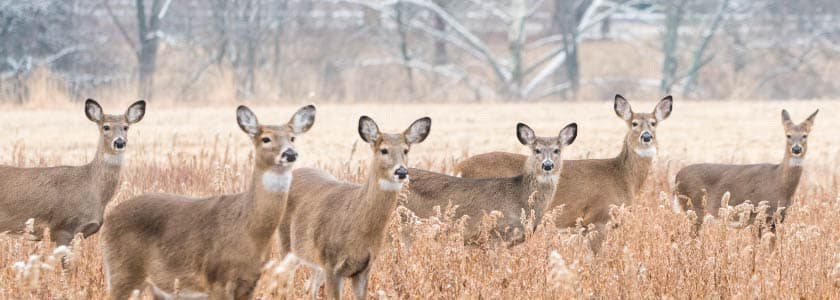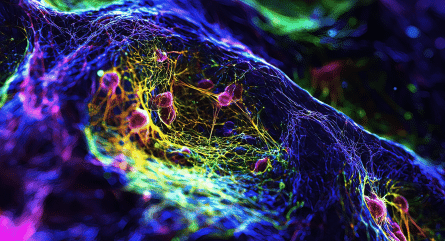You might not know it from the excitement of hunters or from the herds you see munching on the well-manicured yards of America, but the North American deer population is in decline and has been for years.
Deer are found across North and South America, Europe, and most of Asia. In the United States, deer species include caribou, elk, moose, whitetail deer (and its subspecies, the black-tailed deer), and mule deer.
Combined whitetail and mule deer populations likely totaled around 45 million in 1492 and gradually shrank until the 1800s, when herd numbers plunged precipitously. The establishment of hunting seasons and land protection efforts resulted in a staggering rebound, with numbers approaching 40 million by 1960, only to decline again. Currently, there are around 5 million mule deer and 30 million whitetails in the United States, and harvesting numbers fell about 15% between 2000 and 2016. A complicated set of factors is at play, including increased forestation, predation, energy development, drought, and habitat loss.
Deer—regardless of the species—are relatively abundant despite their population decline, and ecologically important, yet little is known about their genetics—a glaring omission, since more knowledge about genetics would aid in conservation and recovery efforts. Now, thanks to a team of Canadian researchers, the genome of the species has been sequenced through next generation sequencing (NGS).
The study identified about 33 million single nucleotide polymorphisms (SNPs) and insertion/deletion (indel) variants, which were used to develop an assay capable of identifying pure mule deer, pure white-tailed deer, and interspecific hybrids. Among the uses of the data is the hope that it could progress the study of chronic wasting disease, which results in drastic weight loss, stumbling, and eventual death.
While key for deer, genetic sequencing has also led to greater understanding of critical species around the world. To date, hundreds of animal genomes have been sequenced, from obscure corals to cockroaches to Physeter macrocephalus, the sperm whale. The first sequencing project, for the roundworm C. elegans, was completed in 1998, with the scope of sequencing efforts ballooning in just the past few years.
NGS has been particularly helpful in the field of conservation biology, where it has been used to generate life histories, demographic information, and phylogenic data for endangered species. One recent example is efforts to study and preserve Africa’s rarest carnivore, the beautiful and wild Ethiopian wolf.
NGS for animals has blossomed as the price of sequencing has fallen, although the ease with which you can sequence your own DNA (any number of companies will do it, some with next-day turnaround, for less than $1,000) should not be confused with the ease of sequencing the genome of a not-previously-sequenced animal. Since no other animals in the species have been sequenced, there is no reference with which to begin putting the genome together.
With an estimated 8.7 million animal species on Earth, sequencing efforts are sometimes a random affair, reports the Smithsonian magazine. Animals may be studied to raise awareness about a species or to delve into potential human benefits. Still, other times studies are undertaken to advance science generally or to help researchers evaluate techniques and technology, and can even be done as a form of public service, such as when Canadian researchers sequenced the beaver genome in celebration of the country’s 150th birthday.
“Although both genetic and genomic data sets can be used to estimate genetic diversity, population structure, and demographic history, genome-scale data, with an increased density of markers across the genome, can provide more accurate estimations of these parameters sometimes resulting in different conservation recommendations,” noted a 2018 article in Genome Biology.
The genomic focus, the article added, also allows researchers to ask different questions than they would if they were studying more traditional parameters. In the future, for example, researchers may be able to manipulate genes to help achieve conservation goals, improve disease resistance, enhance adaptation to changing climates, spread desired traits into a population, or reintroduce genetic material lost due to human effects on ecosystems.
“Genetic approaches have a long history of use in conservation, but the transition to genomic technologies is only just beginning,” the article stated. “By expanding available data sets to the genomic scale, researchers can ask and answer different questions and can thus gain valuable insights that will be applicable to conservation. As genomic technologies continue to advance, the potential for these technologies to impact conservation decisions increases. The knowledge we gain will hopefully enable us to mitigate our impact on the Earth’s biota.”
One recent field application produced a reference genome for wild populations of the red-spotted grouper, an economically important fish whose numbers declined so precipitously that the species is now threatened. Another study boosted the amount of ecological data available for threatened species of Chondrichthyes. By using adapted sequencing techniques, researchers saved time, avoided amplification bias, did away with the need for prior sequencing knowledge, and performed local analysis on a portable computer—and did it all with much less infrastructure than would be needed for PCR-based studies.
Such reference genomes can be used for microsatellite development, the generation of genome-wide SNP analysis, characterization of immune genes, and diet analysis, noted a 2019 study in Genes, which looked specifically at the Tasmanian devil, whose dwindling population is threatened by an infectious cancer. Those attributes can help determine relationships between founders, vaccine development, inbreeding accumulation, diet makeup, and parasite resistance.
“Despite the challenges in obtaining high-quality samples for genome sequencing and expertise for the creation of reference genomes for threatened species, there is value in them. Reduced costs and lower input DNA requirements, as well as improved bioinformatic assembly and annotation pipelines based on non-model, non-eutherian species, mean that these technologies are becoming more attainable by conservation programs and should be used more routinely where budgets allow,” the study’s authors noted. “Reference genomes enable a wealth of genetic/genomic applications and are an important asset in our ongoing fight to preserve global biodiversity.”
Similar efforts are underway to investigate the vanishing crested ibis and other endangered birds. In the case of the ibis, an international group of researchers used high-quality genome sequences of the animal to investigate near-extinction events and confirm the loss of genetic diversity.
Researchers identified “that genetic inbreeding and loss-of-function genes in the crested ibis may all constitute genetic susceptibility to other factors including long-term climate change, over-hunting, and agrochemical overuse. We also establish(ed) a genome-wide DNA identification platform for molecular breeding and conservation practices, to facilitate sustainable recovery of endangered species. These findings demonstrate common genomic signatures of population decline across avian species and pave a way for further effort in saving endangered species and enhancing conservation genomic efforts.”
Of course, NGS is no panacea for the study of wild animals. Sampling may disturb already fragile populations, processing and analysis can take considerable amounts of time, and advances in computational biology and bioinformatics are needed before larger genome studies can take place. As with other facets of NGS research, there is ample hope that future advancements will cut costs and increase efficiency.

























